Evaluating Disruptive vs. Sustaining Innovations in Business Strategy
VerifiedAdded on 2020/04/21
|16
|3359
|192
AI Summary
The assignment delves into distinguishing between disruptive and sustaining innovations within the context of business strategy, emphasizing their implications on market dynamics and competitive advantage. Students are expected to draw from theoretical frameworks such as Kaizen's 5S methodology and Total Quality Management (TQM) principles. By examining case studies like "The Toyota Way," learners will explore how organizations implement these innovation strategies in practice, focusing on managerial approaches and production systems that foster organizational learning and continuous improvement.
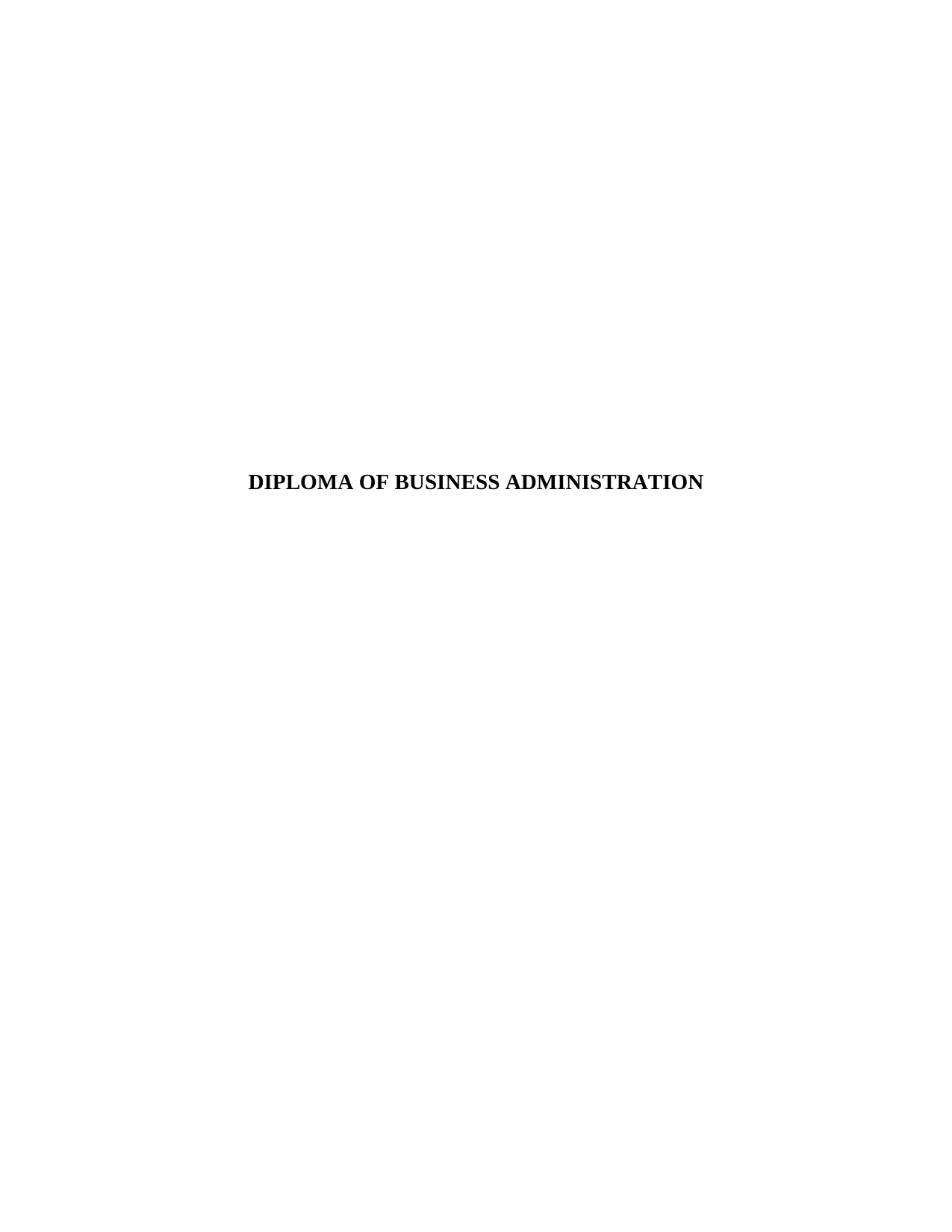
DIPLOMA OF BUSINESS ADMINISTRATION
Paraphrase This Document
Need a fresh take? Get an instant paraphrase of this document with our AI Paraphraser

TABLE OF CONTENTS
PART A: CASE STUDY.................................................................................................................6
About Continuous Improvement and involvement of people in this process and how they
would be enabling improvements................................................................................................6
Describing the types of culture which Corus is developing and finding out the ways in which
vision plan will help to develop this culture................................................................................6
Analyzing how KPIs will help Corus to give satisfaction to its customers.................................7
Evaluating the key benefits of CI in helping Corus for becoming a more innovative and
customer focused organization....................................................................................................7
PART B: CASE STUDY.................................................................................................................8
Describing the meaning of ethical business practices.................................................................8
Explaining sustainable practice that could help a business to compete.......................................8
Analyzing the accuracy of LCA than just looking at the carbon footprint of the ‘usephase’ of a
material........................................................................................................................................9
Evaluating the contribution of Tata Steel for sustainable and ethical business practices............9
ASSESTEMENT TASK 2 – TEAM PROJECT...........................................................................10
Defining the product and its current use by mapping the way product has evolved since its first
invention....................................................................................................................................10
Establishing a need for innovation............................................................................................10
Brainstorming of the ideas.........................................................................................................10
Shortlisting two ideas for trial...................................................................................................11
Cost-benefit analysis for each one.............................................................................................11
Analyzing risks and developing strategies for mitigation.........................................................12
Highlighting sustainability issues..............................................................................................12
Strategies and resources for implementing new idea................................................................12
PART A: CASE STUDY.................................................................................................................6
About Continuous Improvement and involvement of people in this process and how they
would be enabling improvements................................................................................................6
Describing the types of culture which Corus is developing and finding out the ways in which
vision plan will help to develop this culture................................................................................6
Analyzing how KPIs will help Corus to give satisfaction to its customers.................................7
Evaluating the key benefits of CI in helping Corus for becoming a more innovative and
customer focused organization....................................................................................................7
PART B: CASE STUDY.................................................................................................................8
Describing the meaning of ethical business practices.................................................................8
Explaining sustainable practice that could help a business to compete.......................................8
Analyzing the accuracy of LCA than just looking at the carbon footprint of the ‘usephase’ of a
material........................................................................................................................................9
Evaluating the contribution of Tata Steel for sustainable and ethical business practices............9
ASSESTEMENT TASK 2 – TEAM PROJECT...........................................................................10
Defining the product and its current use by mapping the way product has evolved since its first
invention....................................................................................................................................10
Establishing a need for innovation............................................................................................10
Brainstorming of the ideas.........................................................................................................10
Shortlisting two ideas for trial...................................................................................................11
Cost-benefit analysis for each one.............................................................................................11
Analyzing risks and developing strategies for mitigation.........................................................12
Highlighting sustainability issues..............................................................................................12
Strategies and resources for implementing new idea................................................................12
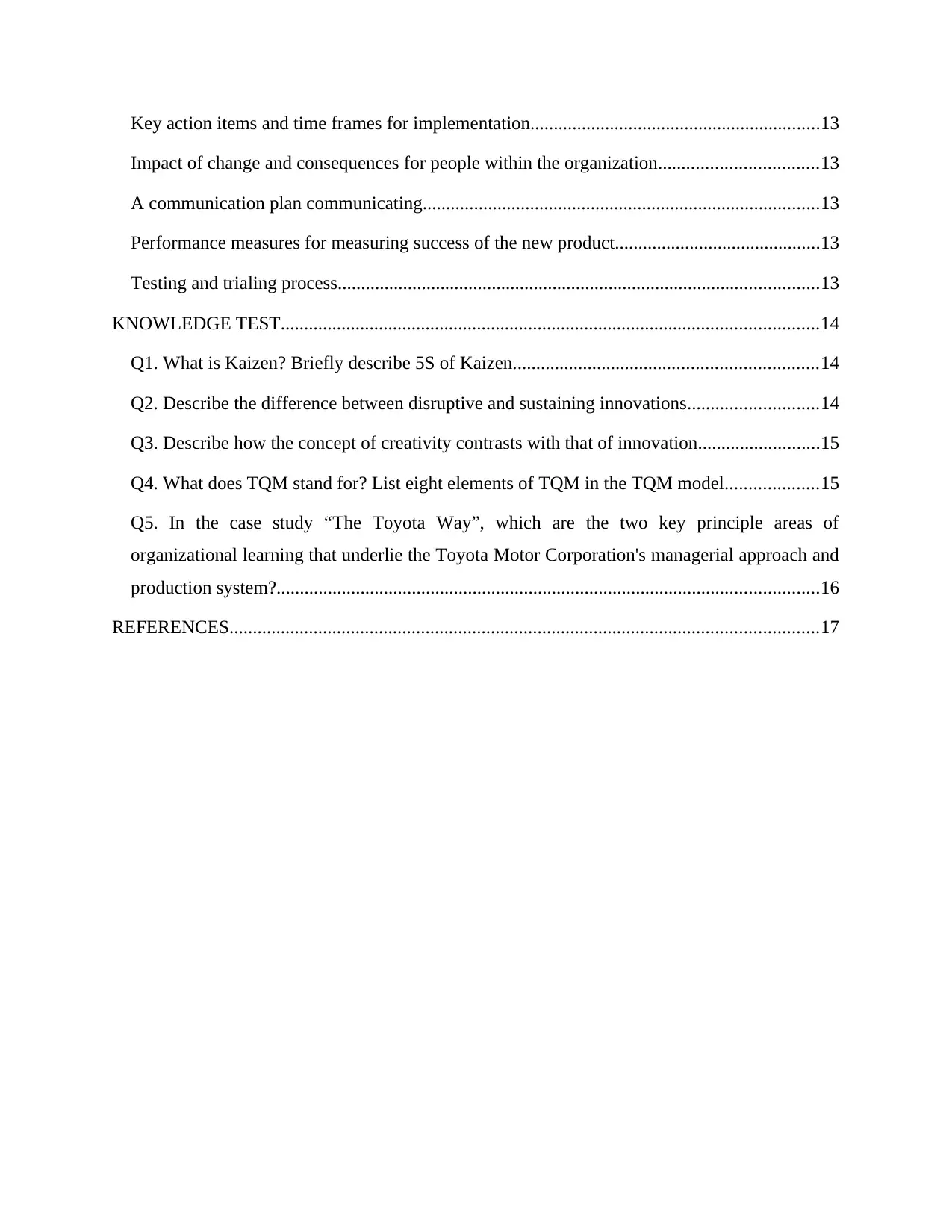
Key action items and time frames for implementation..............................................................13
Impact of change and consequences for people within the organization..................................13
A communication plan communicating.....................................................................................13
Performance measures for measuring success of the new product............................................13
Testing and trialing process.......................................................................................................13
KNOWLEDGE TEST...................................................................................................................14
Q1. What is Kaizen? Briefly describe 5S of Kaizen.................................................................14
Q2. Describe the difference between disruptive and sustaining innovations............................14
Q3. Describe how the concept of creativity contrasts with that of innovation..........................15
Q4. What does TQM stand for? List eight elements of TQM in the TQM model....................15
Q5. In the case study “The Toyota Way”, which are the two key principle areas of
organizational learning that underlie the Toyota Motor Corporation's managerial approach and
production system?....................................................................................................................16
REFERENCES..............................................................................................................................17
Impact of change and consequences for people within the organization..................................13
A communication plan communicating.....................................................................................13
Performance measures for measuring success of the new product............................................13
Testing and trialing process.......................................................................................................13
KNOWLEDGE TEST...................................................................................................................14
Q1. What is Kaizen? Briefly describe 5S of Kaizen.................................................................14
Q2. Describe the difference between disruptive and sustaining innovations............................14
Q3. Describe how the concept of creativity contrasts with that of innovation..........................15
Q4. What does TQM stand for? List eight elements of TQM in the TQM model....................15
Q5. In the case study “The Toyota Way”, which are the two key principle areas of
organizational learning that underlie the Toyota Motor Corporation's managerial approach and
production system?....................................................................................................................16
REFERENCES..............................................................................................................................17
⊘ This is a preview!⊘
Do you want full access?
Subscribe today to unlock all pages.

Trusted by 1+ million students worldwide

Paraphrase This Document
Need a fresh take? Get an instant paraphrase of this document with our AI Paraphraser
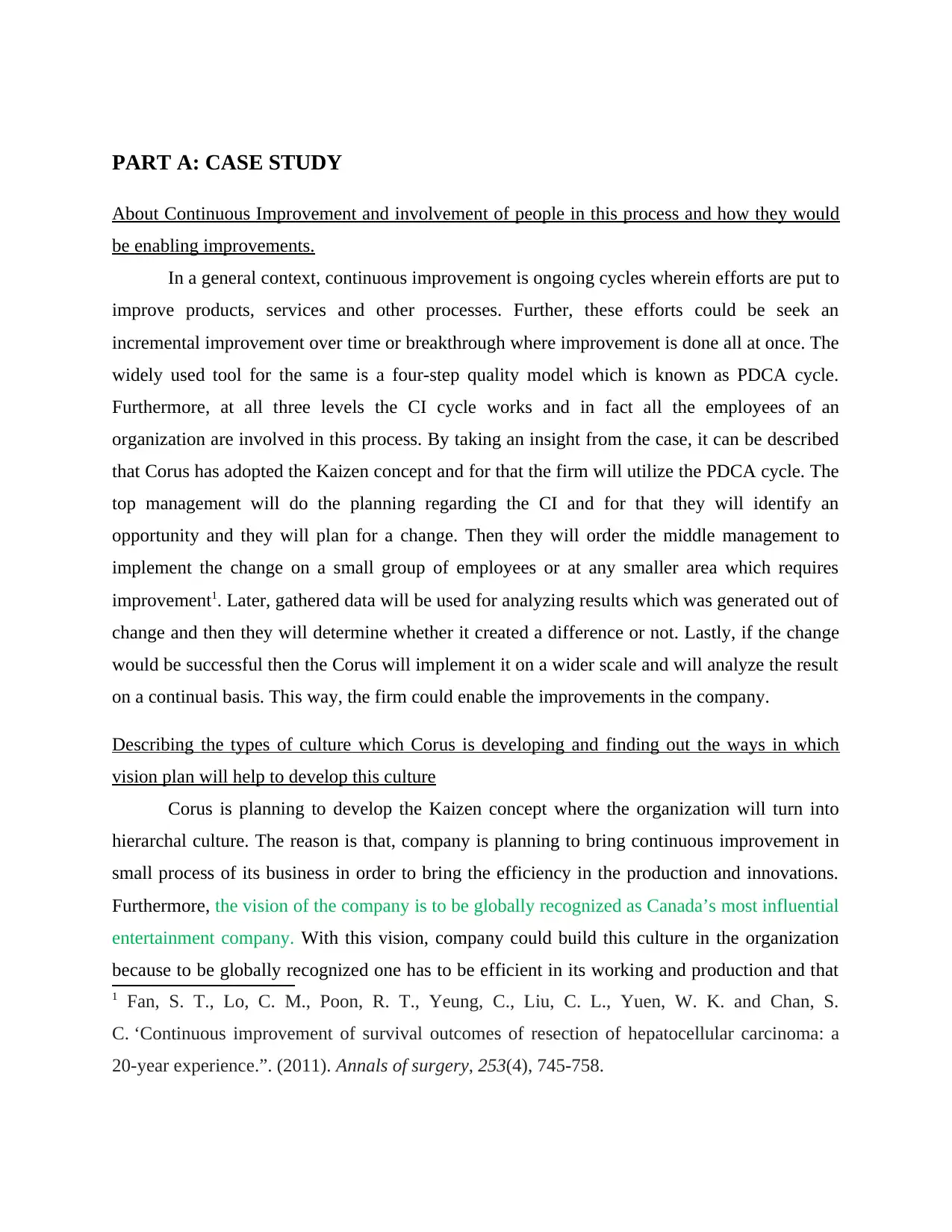
PART A: CASE STUDY
About Continuous Improvement and involvement of people in this process and how they would
be enabling improvements.
In a general context, continuous improvement is ongoing cycles wherein efforts are put to
improve products, services and other processes. Further, these efforts could be seek an
incremental improvement over time or breakthrough where improvement is done all at once. The
widely used tool for the same is a four-step quality model which is known as PDCA cycle.
Furthermore, at all three levels the CI cycle works and in fact all the employees of an
organization are involved in this process. By taking an insight from the case, it can be described
that Corus has adopted the Kaizen concept and for that the firm will utilize the PDCA cycle. The
top management will do the planning regarding the CI and for that they will identify an
opportunity and they will plan for a change. Then they will order the middle management to
implement the change on a small group of employees or at any smaller area which requires
improvement1. Later, gathered data will be used for analyzing results which was generated out of
change and then they will determine whether it created a difference or not. Lastly, if the change
would be successful then the Corus will implement it on a wider scale and will analyze the result
on a continual basis. This way, the firm could enable the improvements in the company.
Describing the types of culture which Corus is developing and finding out the ways in which
vision plan will help to develop this culture
Corus is planning to develop the Kaizen concept where the organization will turn into
hierarchal culture. The reason is that, company is planning to bring continuous improvement in
small process of its business in order to bring the efficiency in the production and innovations.
Furthermore, the vision of the company is to be globally recognized as Canada’s most influential
entertainment company. With this vision, company could build this culture in the organization
because to be globally recognized one has to be efficient in its working and production and that
1 Fan, S. T., Lo, C. M., Poon, R. T., Yeung, C., Liu, C. L., Yuen, W. K. and Chan, S.
C. ‘Continuous improvement of survival outcomes of resection of hepatocellular carcinoma: a
20-year experience.”. (2011). Annals of surgery, 253(4), 745-758.
About Continuous Improvement and involvement of people in this process and how they would
be enabling improvements.
In a general context, continuous improvement is ongoing cycles wherein efforts are put to
improve products, services and other processes. Further, these efforts could be seek an
incremental improvement over time or breakthrough where improvement is done all at once. The
widely used tool for the same is a four-step quality model which is known as PDCA cycle.
Furthermore, at all three levels the CI cycle works and in fact all the employees of an
organization are involved in this process. By taking an insight from the case, it can be described
that Corus has adopted the Kaizen concept and for that the firm will utilize the PDCA cycle. The
top management will do the planning regarding the CI and for that they will identify an
opportunity and they will plan for a change. Then they will order the middle management to
implement the change on a small group of employees or at any smaller area which requires
improvement1. Later, gathered data will be used for analyzing results which was generated out of
change and then they will determine whether it created a difference or not. Lastly, if the change
would be successful then the Corus will implement it on a wider scale and will analyze the result
on a continual basis. This way, the firm could enable the improvements in the company.
Describing the types of culture which Corus is developing and finding out the ways in which
vision plan will help to develop this culture
Corus is planning to develop the Kaizen concept where the organization will turn into
hierarchal culture. The reason is that, company is planning to bring continuous improvement in
small process of its business in order to bring the efficiency in the production and innovations.
Furthermore, the vision of the company is to be globally recognized as Canada’s most influential
entertainment company. With this vision, company could build this culture in the organization
because to be globally recognized one has to be efficient in its working and production and that
1 Fan, S. T., Lo, C. M., Poon, R. T., Yeung, C., Liu, C. L., Yuen, W. K. and Chan, S.
C. ‘Continuous improvement of survival outcomes of resection of hepatocellular carcinoma: a
20-year experience.”. (2011). Annals of surgery, 253(4), 745-758.

could only be achieved if they have all the effective processes. Moreover, affectivity and
efficiency could be brought in only by having continuous improvement in the all the processes of
the firm. Moreover, to adopt CI on a regular basis, management has to keep a close control over
every activity. Hence, the evolvement of hierarchal culture in the firm will start. Therefore, the
vision of the company will help in developing this culture in Corus.
Analyzing how KPIs will help Corus to give satisfaction to its customers
Key performance indicators of Corus are totally based upon the needs and requirements
of customers, like, providing the customized solutions to the customers according to their needs.
They do the meeting on a daily basis just to find a solution how to make the customer satisfy
with their products and services. Moreover, the major KPI of the company is that they have
adopted best practice. Furthermore, they do lean production which gives the result of reduced
waste, improved product quality, recued rework time, becoming competitive by lowering dwn
the cost. Therefore, these KPIs will help out the Corus to provide customer satisfaction.
Moreover, by doing CI, company could generate some more KPIs in order to provide higher
customer satisfaction but the firm must make sure that those KPIs should be working according
to the needs and requirements of customers.
Evaluating the key benefits of CI in helping Corus for becoming a more innovative and customer
focused organization
The company has already made a decision of introducing Kaizen in their firm for
continuous improvement which depicts that the firm already knows the exclusive benefits of CI.
Moreover, there are many more benefits linked to CI which the firm must know about them in
order to keep this culture in the organization despite of any circumstances. Further, to become
more innovative and customer focused organizations, it is essential to do CI on a regular basis as
it will increase the productivity and will improve the quality. Thus, it will help in getting more
customer loyalty. Furthermore, cost will be reduced as well as the employee turnover rate which
is good sign for the firm.
efficiency could be brought in only by having continuous improvement in the all the processes of
the firm. Moreover, to adopt CI on a regular basis, management has to keep a close control over
every activity. Hence, the evolvement of hierarchal culture in the firm will start. Therefore, the
vision of the company will help in developing this culture in Corus.
Analyzing how KPIs will help Corus to give satisfaction to its customers
Key performance indicators of Corus are totally based upon the needs and requirements
of customers, like, providing the customized solutions to the customers according to their needs.
They do the meeting on a daily basis just to find a solution how to make the customer satisfy
with their products and services. Moreover, the major KPI of the company is that they have
adopted best practice. Furthermore, they do lean production which gives the result of reduced
waste, improved product quality, recued rework time, becoming competitive by lowering dwn
the cost. Therefore, these KPIs will help out the Corus to provide customer satisfaction.
Moreover, by doing CI, company could generate some more KPIs in order to provide higher
customer satisfaction but the firm must make sure that those KPIs should be working according
to the needs and requirements of customers.
Evaluating the key benefits of CI in helping Corus for becoming a more innovative and customer
focused organization
The company has already made a decision of introducing Kaizen in their firm for
continuous improvement which depicts that the firm already knows the exclusive benefits of CI.
Moreover, there are many more benefits linked to CI which the firm must know about them in
order to keep this culture in the organization despite of any circumstances. Further, to become
more innovative and customer focused organizations, it is essential to do CI on a regular basis as
it will increase the productivity and will improve the quality. Thus, it will help in getting more
customer loyalty. Furthermore, cost will be reduced as well as the employee turnover rate which
is good sign for the firm.
⊘ This is a preview!⊘
Do you want full access?
Subscribe today to unlock all pages.

Trusted by 1+ million students worldwide
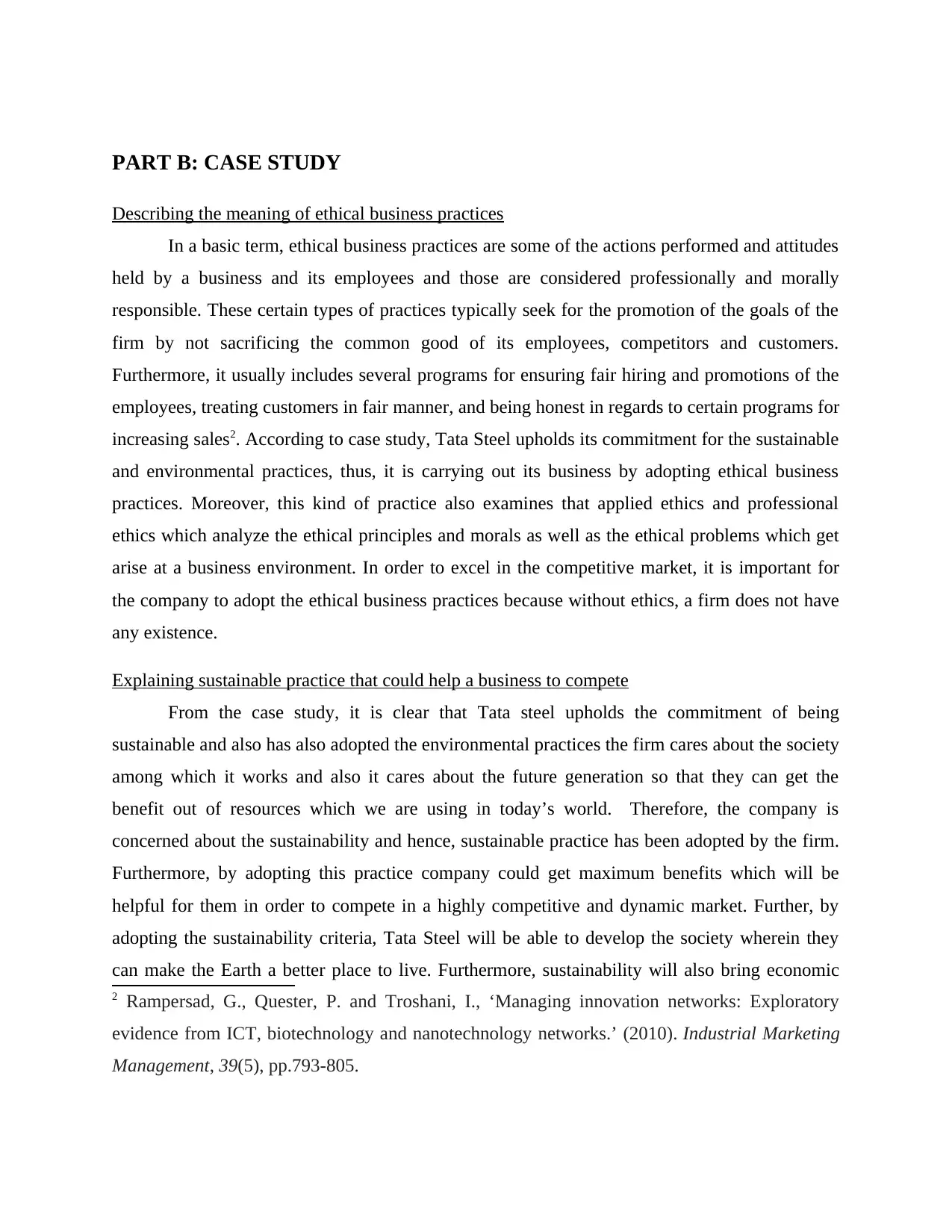
PART B: CASE STUDY
Describing the meaning of ethical business practices
In a basic term, ethical business practices are some of the actions performed and attitudes
held by a business and its employees and those are considered professionally and morally
responsible. These certain types of practices typically seek for the promotion of the goals of the
firm by not sacrificing the common good of its employees, competitors and customers.
Furthermore, it usually includes several programs for ensuring fair hiring and promotions of the
employees, treating customers in fair manner, and being honest in regards to certain programs for
increasing sales2. According to case study, Tata Steel upholds its commitment for the sustainable
and environmental practices, thus, it is carrying out its business by adopting ethical business
practices. Moreover, this kind of practice also examines that applied ethics and professional
ethics which analyze the ethical principles and morals as well as the ethical problems which get
arise at a business environment. In order to excel in the competitive market, it is important for
the company to adopt the ethical business practices because without ethics, a firm does not have
any existence.
Explaining sustainable practice that could help a business to compete
From the case study, it is clear that Tata steel upholds the commitment of being
sustainable and also has also adopted the environmental practices the firm cares about the society
among which it works and also it cares about the future generation so that they can get the
benefit out of resources which we are using in today’s world. Therefore, the company is
concerned about the sustainability and hence, sustainable practice has been adopted by the firm.
Furthermore, by adopting this practice company could get maximum benefits which will be
helpful for them in order to compete in a highly competitive and dynamic market. Further, by
adopting the sustainability criteria, Tata Steel will be able to develop the society wherein they
can make the Earth a better place to live. Furthermore, sustainability will also bring economic
2 Rampersad, G., Quester, P. and Troshani, I., ‘Managing innovation networks: Exploratory
evidence from ICT, biotechnology and nanotechnology networks.’ (2010). Industrial Marketing
Management, 39(5), pp.793-805.
Describing the meaning of ethical business practices
In a basic term, ethical business practices are some of the actions performed and attitudes
held by a business and its employees and those are considered professionally and morally
responsible. These certain types of practices typically seek for the promotion of the goals of the
firm by not sacrificing the common good of its employees, competitors and customers.
Furthermore, it usually includes several programs for ensuring fair hiring and promotions of the
employees, treating customers in fair manner, and being honest in regards to certain programs for
increasing sales2. According to case study, Tata Steel upholds its commitment for the sustainable
and environmental practices, thus, it is carrying out its business by adopting ethical business
practices. Moreover, this kind of practice also examines that applied ethics and professional
ethics which analyze the ethical principles and morals as well as the ethical problems which get
arise at a business environment. In order to excel in the competitive market, it is important for
the company to adopt the ethical business practices because without ethics, a firm does not have
any existence.
Explaining sustainable practice that could help a business to compete
From the case study, it is clear that Tata steel upholds the commitment of being
sustainable and also has also adopted the environmental practices the firm cares about the society
among which it works and also it cares about the future generation so that they can get the
benefit out of resources which we are using in today’s world. Therefore, the company is
concerned about the sustainability and hence, sustainable practice has been adopted by the firm.
Furthermore, by adopting this practice company could get maximum benefits which will be
helpful for them in order to compete in a highly competitive and dynamic market. Further, by
adopting the sustainability criteria, Tata Steel will be able to develop the society wherein they
can make the Earth a better place to live. Furthermore, sustainability will also bring economic
2 Rampersad, G., Quester, P. and Troshani, I., ‘Managing innovation networks: Exploratory
evidence from ICT, biotechnology and nanotechnology networks.’ (2010). Industrial Marketing
Management, 39(5), pp.793-805.
Paraphrase This Document
Need a fresh take? Get an instant paraphrase of this document with our AI Paraphraser
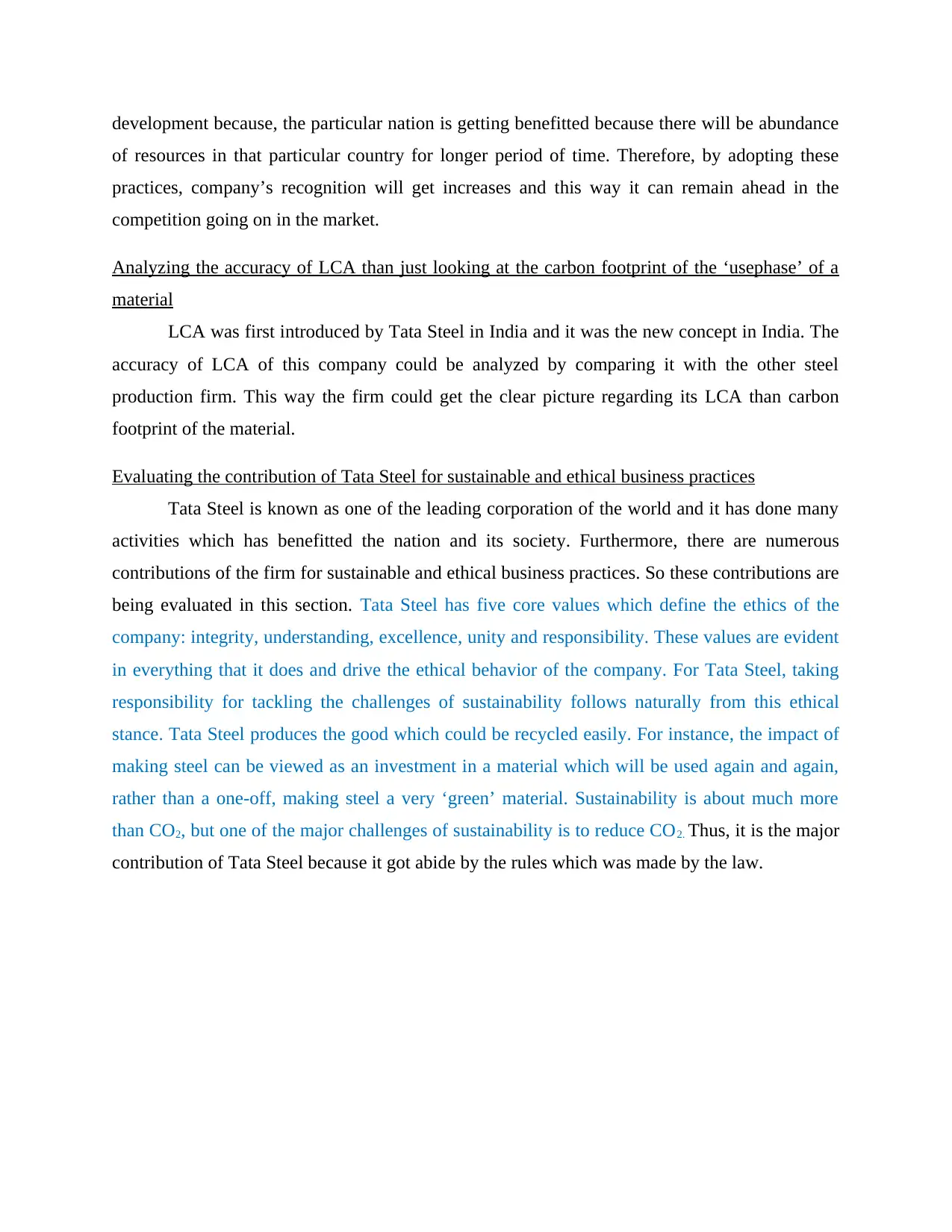
development because, the particular nation is getting benefitted because there will be abundance
of resources in that particular country for longer period of time. Therefore, by adopting these
practices, company’s recognition will get increases and this way it can remain ahead in the
competition going on in the market.
Analyzing the accuracy of LCA than just looking at the carbon footprint of the ‘usephase’ of a
material
LCA was first introduced by Tata Steel in India and it was the new concept in India. The
accuracy of LCA of this company could be analyzed by comparing it with the other steel
production firm. This way the firm could get the clear picture regarding its LCA than carbon
footprint of the material.
Evaluating the contribution of Tata Steel for sustainable and ethical business practices
Tata Steel is known as one of the leading corporation of the world and it has done many
activities which has benefitted the nation and its society. Furthermore, there are numerous
contributions of the firm for sustainable and ethical business practices. So these contributions are
being evaluated in this section. Tata Steel has five core values which define the ethics of the
company: integrity, understanding, excellence, unity and responsibility. These values are evident
in everything that it does and drive the ethical behavior of the company. For Tata Steel, taking
responsibility for tackling the challenges of sustainability follows naturally from this ethical
stance. Tata Steel produces the good which could be recycled easily. For instance, the impact of
making steel can be viewed as an investment in a material which will be used again and again,
rather than a one-off, making steel a very ‘green’ material. Sustainability is about much more
than CO2, but one of the major challenges of sustainability is to reduce CO2. Thus, it is the major
contribution of Tata Steel because it got abide by the rules which was made by the law.
of resources in that particular country for longer period of time. Therefore, by adopting these
practices, company’s recognition will get increases and this way it can remain ahead in the
competition going on in the market.
Analyzing the accuracy of LCA than just looking at the carbon footprint of the ‘usephase’ of a
material
LCA was first introduced by Tata Steel in India and it was the new concept in India. The
accuracy of LCA of this company could be analyzed by comparing it with the other steel
production firm. This way the firm could get the clear picture regarding its LCA than carbon
footprint of the material.
Evaluating the contribution of Tata Steel for sustainable and ethical business practices
Tata Steel is known as one of the leading corporation of the world and it has done many
activities which has benefitted the nation and its society. Furthermore, there are numerous
contributions of the firm for sustainable and ethical business practices. So these contributions are
being evaluated in this section. Tata Steel has five core values which define the ethics of the
company: integrity, understanding, excellence, unity and responsibility. These values are evident
in everything that it does and drive the ethical behavior of the company. For Tata Steel, taking
responsibility for tackling the challenges of sustainability follows naturally from this ethical
stance. Tata Steel produces the good which could be recycled easily. For instance, the impact of
making steel can be viewed as an investment in a material which will be used again and again,
rather than a one-off, making steel a very ‘green’ material. Sustainability is about much more
than CO2, but one of the major challenges of sustainability is to reduce CO2. Thus, it is the major
contribution of Tata Steel because it got abide by the rules which was made by the law.
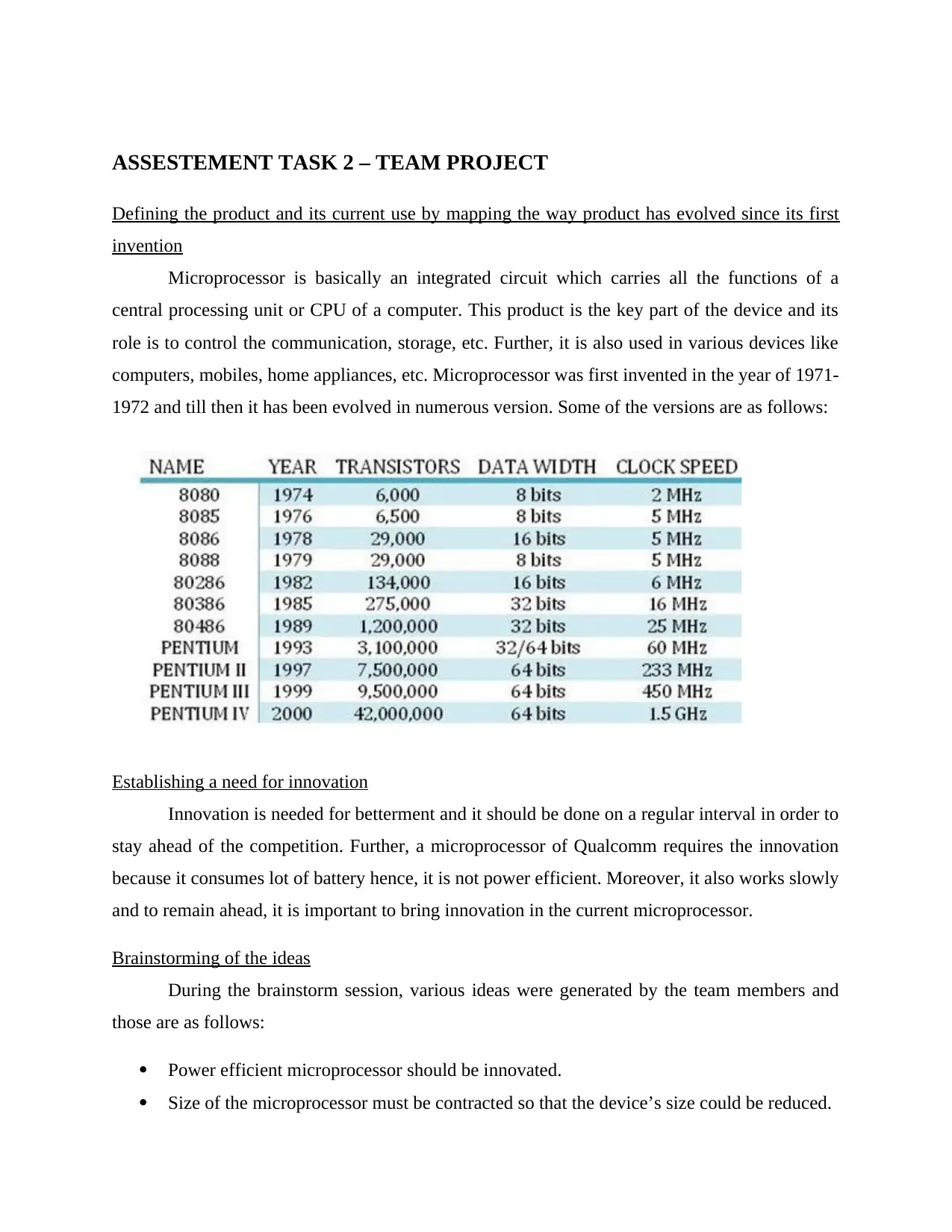
ASSESTEMENT TASK 2 – TEAM PROJECT
Defining the product and its current use by mapping the way product has evolved since its first
invention
Microprocessor is basically an integrated circuit which carries all the functions of a
central processing unit or CPU of a computer. This product is the key part of the device and its
role is to control the communication, storage, etc. Further, it is also used in various devices like
computers, mobiles, home appliances, etc. Microprocessor was first invented in the year of 1971-
1972 and till then it has been evolved in numerous version. Some of the versions are as follows:
Establishing a need for innovation
Innovation is needed for betterment and it should be done on a regular interval in order to
stay ahead of the competition. Further, a microprocessor of Qualcomm requires the innovation
because it consumes lot of battery hence, it is not power efficient. Moreover, it also works slowly
and to remain ahead, it is important to bring innovation in the current microprocessor.
Brainstorming of the ideas
During the brainstorm session, various ideas were generated by the team members and
those are as follows:
Power efficient microprocessor should be innovated.
Size of the microprocessor must be contracted so that the device’s size could be reduced.
Defining the product and its current use by mapping the way product has evolved since its first
invention
Microprocessor is basically an integrated circuit which carries all the functions of a
central processing unit or CPU of a computer. This product is the key part of the device and its
role is to control the communication, storage, etc. Further, it is also used in various devices like
computers, mobiles, home appliances, etc. Microprocessor was first invented in the year of 1971-
1972 and till then it has been evolved in numerous version. Some of the versions are as follows:
Establishing a need for innovation
Innovation is needed for betterment and it should be done on a regular interval in order to
stay ahead of the competition. Further, a microprocessor of Qualcomm requires the innovation
because it consumes lot of battery hence, it is not power efficient. Moreover, it also works slowly
and to remain ahead, it is important to bring innovation in the current microprocessor.
Brainstorming of the ideas
During the brainstorm session, various ideas were generated by the team members and
those are as follows:
Power efficient microprocessor should be innovated.
Size of the microprocessor must be contracted so that the device’s size could be reduced.
⊘ This is a preview!⊘
Do you want full access?
Subscribe today to unlock all pages.

Trusted by 1+ million students worldwide
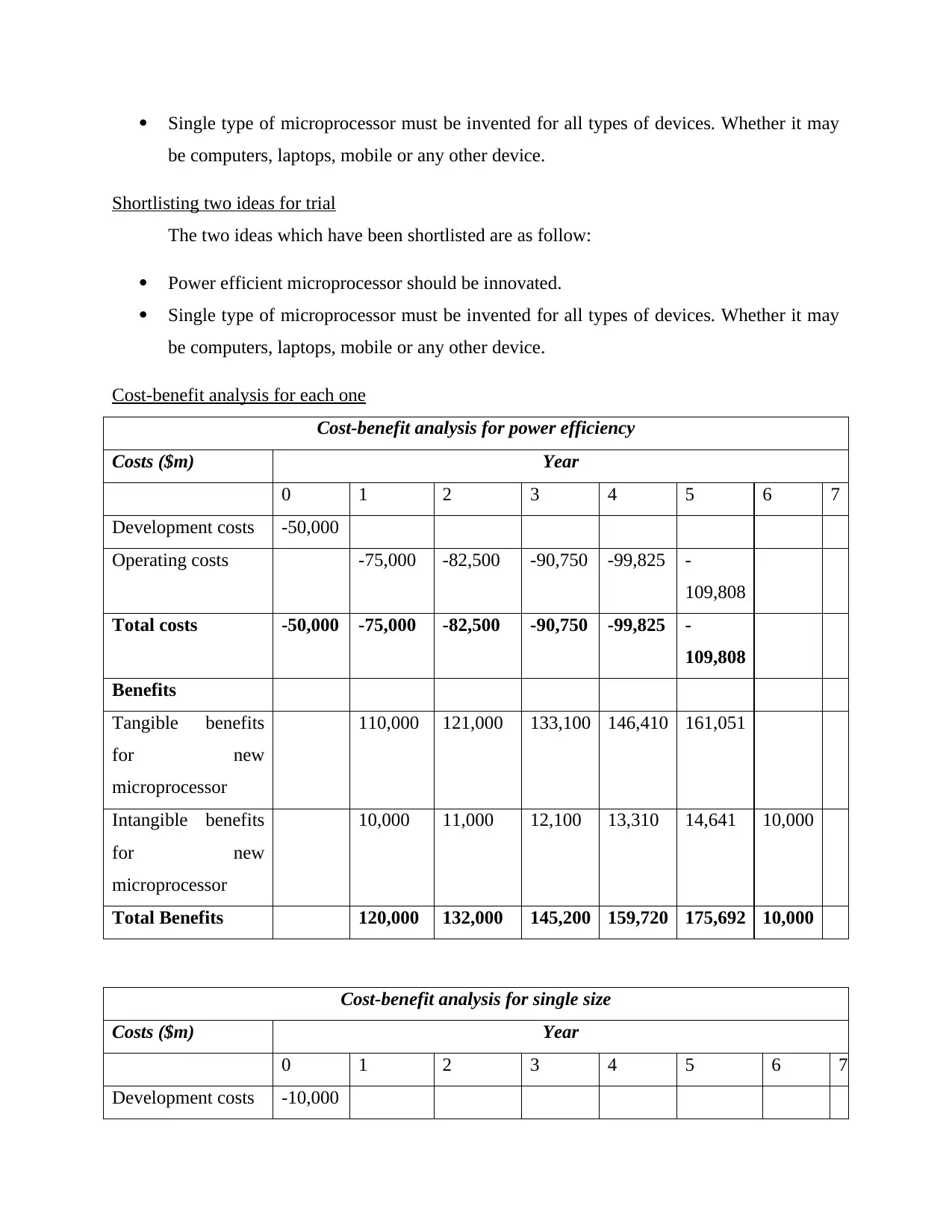
Single type of microprocessor must be invented for all types of devices. Whether it may
be computers, laptops, mobile or any other device.
Shortlisting two ideas for trial
The two ideas which have been shortlisted are as follow:
Power efficient microprocessor should be innovated.
Single type of microprocessor must be invented for all types of devices. Whether it may
be computers, laptops, mobile or any other device.
Cost-benefit analysis for each one
Cost-benefit analysis for power efficiency
Costs ($m) Year
0 1 2 3 4 5 6 7
Development costs -50,000
Operating costs -75,000 -82,500 -90,750 -99,825 -
109,808
Total costs -50,000 -75,000 -82,500 -90,750 -99,825 -
109,808
Benefits
Tangible benefits
for new
microprocessor
110,000 121,000 133,100 146,410 161,051
Intangible benefits
for new
microprocessor
10,000 11,000 12,100 13,310 14,641 10,000
Total Benefits 120,000 132,000 145,200 159,720 175,692 10,000
Cost-benefit analysis for single size
Costs ($m) Year
0 1 2 3 4 5 6 7
Development costs -10,000
be computers, laptops, mobile or any other device.
Shortlisting two ideas for trial
The two ideas which have been shortlisted are as follow:
Power efficient microprocessor should be innovated.
Single type of microprocessor must be invented for all types of devices. Whether it may
be computers, laptops, mobile or any other device.
Cost-benefit analysis for each one
Cost-benefit analysis for power efficiency
Costs ($m) Year
0 1 2 3 4 5 6 7
Development costs -50,000
Operating costs -75,000 -82,500 -90,750 -99,825 -
109,808
Total costs -50,000 -75,000 -82,500 -90,750 -99,825 -
109,808
Benefits
Tangible benefits
for new
microprocessor
110,000 121,000 133,100 146,410 161,051
Intangible benefits
for new
microprocessor
10,000 11,000 12,100 13,310 14,641 10,000
Total Benefits 120,000 132,000 145,200 159,720 175,692 10,000
Cost-benefit analysis for single size
Costs ($m) Year
0 1 2 3 4 5 6 7
Development costs -10,000
Paraphrase This Document
Need a fresh take? Get an instant paraphrase of this document with our AI Paraphraser
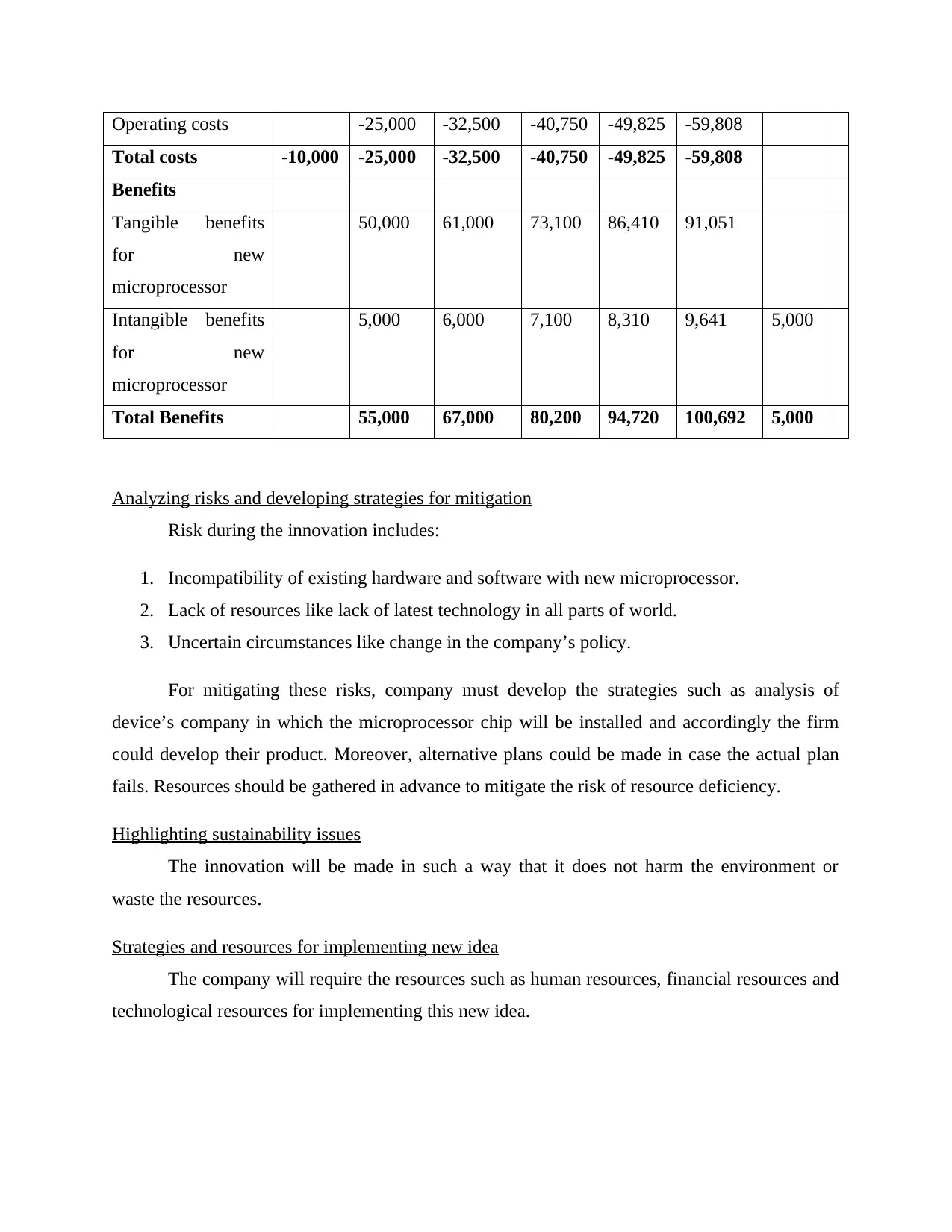
Operating costs -25,000 -32,500 -40,750 -49,825 -59,808
Total costs -10,000 -25,000 -32,500 -40,750 -49,825 -59,808
Benefits
Tangible benefits
for new
microprocessor
50,000 61,000 73,100 86,410 91,051
Intangible benefits
for new
microprocessor
5,000 6,000 7,100 8,310 9,641 5,000
Total Benefits 55,000 67,000 80,200 94,720 100,692 5,000
Analyzing risks and developing strategies for mitigation
Risk during the innovation includes:
1. Incompatibility of existing hardware and software with new microprocessor.
2. Lack of resources like lack of latest technology in all parts of world.
3. Uncertain circumstances like change in the company’s policy.
For mitigating these risks, company must develop the strategies such as analysis of
device’s company in which the microprocessor chip will be installed and accordingly the firm
could develop their product. Moreover, alternative plans could be made in case the actual plan
fails. Resources should be gathered in advance to mitigate the risk of resource deficiency.
Highlighting sustainability issues
The innovation will be made in such a way that it does not harm the environment or
waste the resources.
Strategies and resources for implementing new idea
The company will require the resources such as human resources, financial resources and
technological resources for implementing this new idea.
Total costs -10,000 -25,000 -32,500 -40,750 -49,825 -59,808
Benefits
Tangible benefits
for new
microprocessor
50,000 61,000 73,100 86,410 91,051
Intangible benefits
for new
microprocessor
5,000 6,000 7,100 8,310 9,641 5,000
Total Benefits 55,000 67,000 80,200 94,720 100,692 5,000
Analyzing risks and developing strategies for mitigation
Risk during the innovation includes:
1. Incompatibility of existing hardware and software with new microprocessor.
2. Lack of resources like lack of latest technology in all parts of world.
3. Uncertain circumstances like change in the company’s policy.
For mitigating these risks, company must develop the strategies such as analysis of
device’s company in which the microprocessor chip will be installed and accordingly the firm
could develop their product. Moreover, alternative plans could be made in case the actual plan
fails. Resources should be gathered in advance to mitigate the risk of resource deficiency.
Highlighting sustainability issues
The innovation will be made in such a way that it does not harm the environment or
waste the resources.
Strategies and resources for implementing new idea
The company will require the resources such as human resources, financial resources and
technological resources for implementing this new idea.
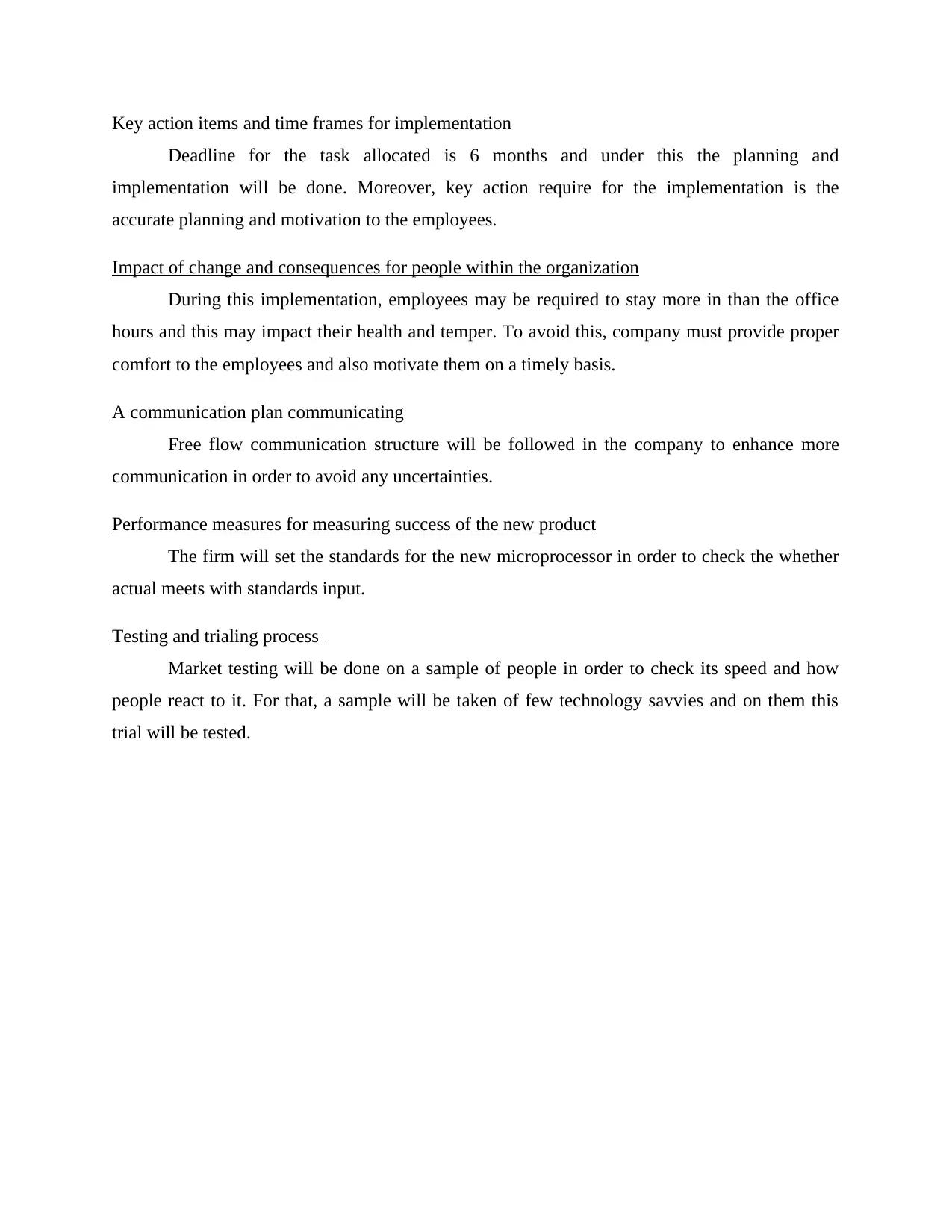
Key action items and time frames for implementation
Deadline for the task allocated is 6 months and under this the planning and
implementation will be done. Moreover, key action require for the implementation is the
accurate planning and motivation to the employees.
Impact of change and consequences for people within the organization
During this implementation, employees may be required to stay more in than the office
hours and this may impact their health and temper. To avoid this, company must provide proper
comfort to the employees and also motivate them on a timely basis.
A communication plan communicating
Free flow communication structure will be followed in the company to enhance more
communication in order to avoid any uncertainties.
Performance measures for measuring success of the new product
The firm will set the standards for the new microprocessor in order to check the whether
actual meets with standards input.
Testing and trialing process
Market testing will be done on a sample of people in order to check its speed and how
people react to it. For that, a sample will be taken of few technology savvies and on them this
trial will be tested.
Deadline for the task allocated is 6 months and under this the planning and
implementation will be done. Moreover, key action require for the implementation is the
accurate planning and motivation to the employees.
Impact of change and consequences for people within the organization
During this implementation, employees may be required to stay more in than the office
hours and this may impact their health and temper. To avoid this, company must provide proper
comfort to the employees and also motivate them on a timely basis.
A communication plan communicating
Free flow communication structure will be followed in the company to enhance more
communication in order to avoid any uncertainties.
Performance measures for measuring success of the new product
The firm will set the standards for the new microprocessor in order to check the whether
actual meets with standards input.
Testing and trialing process
Market testing will be done on a sample of people in order to check its speed and how
people react to it. For that, a sample will be taken of few technology savvies and on them this
trial will be tested.
⊘ This is a preview!⊘
Do you want full access?
Subscribe today to unlock all pages.

Trusted by 1+ million students worldwide
1 out of 16
Related Documents
Your All-in-One AI-Powered Toolkit for Academic Success.
+13062052269
info@desklib.com
Available 24*7 on WhatsApp / Email
![[object Object]](/_next/static/media/star-bottom.7253800d.svg)
Unlock your academic potential
Copyright © 2020–2025 A2Z Services. All Rights Reserved. Developed and managed by ZUCOL.





